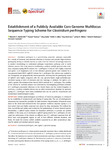Establishment of a Publicly Available Core Genome Multilocus Sequence Typing Scheme for Clostridium perfringens
Abdel-Glil, Mostafa Y.
Thomas, Prasad
Linde, Jörg
Jolley, Keith A.
Harmsen, Dag
Wieler, Lothar H.
Neubauer, Heinrich
Seyboldt, Christian
Clostridium perfringens is a spore-forming anaerobic pathogen responsible
for a variety of histotoxic and intestinal infections in humans and animals. High-resolution
genotyping aiming to identify bacteria at strain level has become increasingly important
in modern microbiology to understand pathogen transmission pathways and to tackle
infection sources. This study aimed at establishing a publicly available genome-wide multilocus
sequence-typing (MLST) scheme for C. perfringens. A total of 1,431 highly conserved
core genes (1.34 megabases; 50% of the reference genome genes) were indexed for a
core genome-based MLST (cgMLST) scheme for C. perfringens. The scheme was applied to
282 ecologically and geographically diverse genomes, showing that the genotyping results
of cgMLST were highly congruent with the core genome-based single-nucleotide-polymorphism
typing in terms of resolution and tree topology. In addition, the cgMLST provided
a greater discrimination than classical MLST methods for C. perfringens. The usability
of the scheme for outbreak analysis was confirmed by reinvestigating published outbreaks
of C. perfringens-associated infections in the United States and the United Kingdom. In
summary, a publicly available scheme and an allele nomenclature database for genomic
typing of C. perfringens have been established and can be used for broad-based and
standardized epidemiological studies.
IMPORTANCE: Global epidemiological surveillance of bacterial pathogens is enhanced
by the availability of standard tools and sharing of typing data. The use of whole-genome
sequencing has opened the possibility for high-resolution characterization of bacterial strains
down to the clonal and subclonal levels. Core genome multilocus sequence typing is a robust
system that uses highly conserved core genes for deep genotyping. The method has
been successfully and widely used to describe the epidemiology of various bacterial species.
Nevertheless, a cgMLST typing scheme for Clostridium perfringens is currently not publicly
available. In this study, we (i) developed a cgMLST typing scheme for C. perfringens, (ii) evaluated
the performance of the scheme on different sets of C. perfringens genomes from different
hosts and geographic regions as well as from different outbreak situations, and,
finally, (iii) made this scheme publicly available supported by an allele nomenclature database
for global and standard genomic typing.
Dateien zu dieser Publikation

